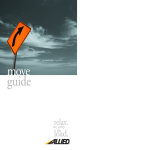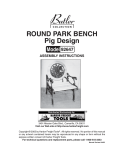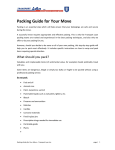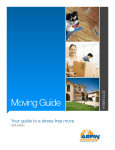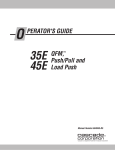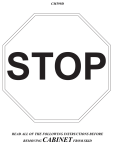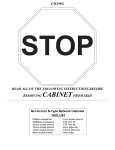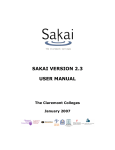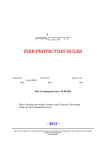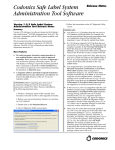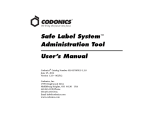Download pdf - the New Advance Transportation Website
Transcript
AVL_moveguide 2/2/05 3:59 PM Page 1 move guide For more information visit www.allied.com or contact your local Allied agent. © 2005 Allied Van Lines, Inc. U.S. DOT No. 076235 Item 91118 (Rev. 2/05) AVL_moveguide 2/2/05 3:59 PM Page 3 relax… feel prepared, not overwhelmed. As moving day approaches, numerous questions and concerns go through your mind. Whether you’ve done this once or a hundred times, there’s a lot to do before the big day. That’s where we can help. The purpose of this two-part booklet is to help you feel prepared, not overwhelmed. You’ll find: • Information on what to expect throughout the moving process • An organized plan for the weeks and days leading up to moving day • Valuable packing hints and reminders based on our many years of experience Part one of this booklet will help you prepare for moving day, including a convenient week-by-week pull-out checklist. We explain: • The responsibilities of your Allied relocation team • The options you have for ensuring the safe arrival of all your possessions • Precautions to take for special members of your family and your most treasured or fragile belongings Part two gets down to the details of packing including: • A guide to your Allied Van Lines packing options • Packing tips if you choose to do it yourself • Packing materials and supplies available for your use • A list of regulated or restricted items (what you can’t transport) Be sure to read through this information and keep it close at hand. It’s just one more way we help you relax…while we carry the load. AVL_moveguide 2/2/05 3:59 PM Page 5 plan Make the most of your time and effort a million questions. a thousand to-do’s. all the help you need. Whether you’re moving around the corner or to the other side of the world, the more information you have, the more prepared you’ll be. Ask questions, get answers, let us help. Interstate vs. Local Relocations Does it really matter whether you’re moving nearby or long-distance? Yes. There are some significant differences between a local and an interstate move. You probably already know that the secret to any successful effort is having a good plan. That’s our philosophy at Allied, too. This section gives you some basic but important information to help make your moving plan as thorough and as time and cost efficient as possible. • If your relocation will be within the state you currently live in, you’ll work with a single, locally-based moving company - Your estimate and charges usually are based on an established hourly fee for the time it takes for the movers to handle your shipment plus the cost of the special services you request • If you are moving to another state the moving process normally involves more than one Allied agent - The cost of an interstate move is typically based on total weight of the shipment, distance between the two locations and any special services required Regulations can differ from state to state, so check with your local Allied agent on what applies for your move. planning AVL_moveguide 2/2/05 3:59 PM Page 7 Plenty of knowledgeable helping hands Your relocation will be carefully guided by members of your Allied moving team. teamwork The first member you’ll meet from your professional moving team is your Personal Relocation Consultant. This person is responsible for: • Advising you and your family on every aspect of your move • Explaining the many services and service options available from Allied Van Lines • Performing a survey of everything in your home that will be moved • Pointing out items that can’t be moved or will require special attention • Providing an estimate of costs • Determining the best moving date for your schedule • Coordinating your professional packing team (if requested) • Answering any questions or concerns you may have planning | team Your Allied Driver and Pack-and-Load Technicians are key members of your moving team, responsible for: • Taking special precautions to protect your home and its contents on moving day • Preparing a detailed Inventory & Condition Report of the items to be moved • Tagging each carton/item with numbered and color-coded labels • Loading your goods onto the truck • Providing a Bill of Lading (a shipping contract) authorizing transport of your possessions • Delivering your belongings to your new home safe and sound If your move is to another state, a local Destination Agent will handle the following: • Completion of all final paperwork • Arrangements for unpacking and removal of the empty cartons and packing materials (if ordered) AVL_moveguide 2/2/05 3:59 PM Page 9 Why consider ECP? Let’s say you bought your new large screen television for $1,600 and it weighs 150 pounds. With ECP, if the television is damaged beyond repair during the move, you receive full replacement value.* In comparison, with Basic coverage, your coverage is limited to $0.60 per pound of the item. Plan Compensation ECP $1,600.00 (Full replacement value) Basic Coverage $90.00 (150 lbs. times $.60/lb.) In addition, homeowner‘s insurance policies vary greatly and may include little or no coverage for your belongings on moving day. As you can see, ECP offers the best possible protection for your belongings. Talk with your Relocation Consultant to help decide what's right for you. beyond bubble wrap In rare instances, an item may be damaged during the move. That’s why Allied offers valuation protection. It’s protection that allows us to rectify the situation quickly, keeping you happy during your relocation. Extra Care Protection...Your Optimal Coverage Allied offers you total peace of mind with Extra Care Protection (ECP), the most comprehensive protection plan in the industry. ECP provides the full replacement value or cost of repair for any household item that may be lost or damaged during your move, up to the value you declare. We’ll do our best to handle claims in a quick, hassle-free way. You’ll receive a settlement offer from us within 30 days or we’ll pay you $50 a day up to $500. planning | peace of mind Coverage of Pairs or Sets ECP coverage extends to matched sets and pairs such as lamps, candlesticks, end tables and dining room chairs. If you choose Extra Care Protection, and the exact replacement can’t be found, you will be compensated for a new set.* Extra Care for Your Valuables Allied's liability for high-value items is limited to $100 per pound. But for items that exceed $100 per pound in value, we'll help you prepare an inventory with our Allied High Value Inventory Form. Present it to us prior to packing, and Allied will provide you with ECP protection up to the full declared value of the item. See your Relocation Consultant for more details.** Basic Liability Protection We also offer Basic Liability Protection, which provides repair or replacement up to a maximum of $0.60 per pound per article should your goods get damaged or lost during the move. There is no charge for Basic Liability Protection. But keep in mind, when it comes to protecting your belongings, one size does not fit all. The level of protection you need may be greater than minimum levels based on your total shipment weight. Be sure to consider high-value items such as artwork, electronic equipment, crystal and porcelain collectibles when choosing the best protection plan for your belongings. *See the terms and conditions specified on the Allied Protection Plan Worksheet and Allied’s published tariffs. Complete replacement of multiple item sets of china, gold and silver flatware, and crystal glassware are excluded from pairs and sets protection under the ECP Plan. **ECP is subject to the declared value of the entire shipment. AVL_moveguide 2/2/05 3:59 PM Page 11 Getting kids through the move…smiling How? Be sensitive to their feelings and concerns. Make little ones feel they’re a part of the process throughout the move. kid care Children love a good adventure and will most likely embrace the moving process if they are involved in all aspects along the way. Here are some tips for getting your kids excited about your move. Remember: • Tell your children about the move as soon as possible so they don’t overhear the news by accident • Talk with them, sharing the details you think they’ll understand — ask about and listen to their reactions • Children of different ages respond differently to a move. For example: - Younger children tend to miss familiar people like a favorite teacher, as well as safe and secure environments like church, school or even their bedrooms - Older children, especially teenagers, tend to miss their friends and others in the community with whom they have relationships planning | special care • Involve your children in all aspects of your relocation, if possible, including house hunting, planning the move, and tasks that are age appropriate • Have children help pack a special box with their most treasured possessions —they can even decorate the outside of the box so they can quickly identify it in your new home • Ask for their input on decorating or arranging things in their new rooms • Encourage your children to take the time to say good-bye to friends and maintain ties by exchanging contact information • Make plans to continue your child’s current activities (such as Scouts, sports, dance classes, etc.) in your new community —continuity will make adjusting to a new location much easier AVL_moveguide 2/2/05 3:59 PM Page 13 Comforting thoughts for pets There are some things you can do to ease the stress of moving the family pets to your new home: pet care • Before leaving, schedule a veterinary examination to check your pet’s health, obtain copies of vaccination records and a health certificate (if required), update identification tags, and discuss a tranquilizer or precautionary measures for the trip • If traveling to your new home by car, make sure to get your pet comfortable to auto travel by taking it on short trips around the neighborhood - Don’t feed your pet for seven hours prior to your trip, pack a container of fresh, cool water, and stop frequently for walks - If stopping at a hotel overnight, make sure the hotel allows pets - Never leave your pet in the car alone - Birds and small pets such as hamsters can travel in their cages if the cage can be placed in a stable, well ventilated area free of drafts (covering the cage while the car is moving often calms an animal) planning | special care • If shipping your pet by air, contact the airline well in advance to check regulations and services: - Consider direct flights to minimize the amount of time your pet will be confined - Select a portable air-transport kennel that’s large enough for your pet to stand and move around a bit - Let your pet get accustomed to the kennel well in advance of the trip - Don’t forget to mark the kennel with "Live Animal," your pet’s name, your new address and phone number, and any special handling instructions - After boarding your plane, ask the flight attendant to confirm your pet has been loaded on the plane AVL_moveguide 2/2/05 4:00 PM Page 15 Preventing growing pains for your plants If you are determined to keep your daisies and dahlias, remember that moving vans are not designed to transport plants. plant care As a general rule, moving companies will not accept liability for safe transport of plants. In addition, some states have rules prohibiting the transport of certain plants across state lines. Check with your Allied agent to see if plants are allowed for your move. However, if you still wish to attempt transport, keep the following in mind: • Provide plants with extra sunlight for several weeks prior to moving day to allow them to store extra energy • Prune back overgrown leaves and branches about a month before moving, and curtail feeding to minimize growth • Thoroughly water the plant the day before you move, and cover it with a plastic bag to retain moisture and warmth • Place the plant in a sturdy carton to keep it from tipping over planning | special care vehicle care Cars, mini-vans, pickup trucks and boats can be transported to your new home by Allied on an auto transport carrier, or in some cases, aboard the moving van. Ask your Personal Relocation Consultant for details, and remember: • Automobiles should have as little fuel in the gas tank as possible • Check automobiles for any oil, battery acid or radiator fluid leaks • Boats should be drained of all fuel and oil in the motor AVL_moveguide 2/2/05 4:00 PM Page 17 Quick Tip > It’s best to pack electronics such as monitors and other equipment in their original packaging. What to expect on moving day When the big day finally arrives, here’s a general idea of what will happen: wrap up • If you ordered packing, a team of specially-trained packers will arrive on or before loading day, depending on how much packing needs to be done. • Before loading, the driver will protect your home and its contents by laying floor runners over carpets and flooring and by padding banisters and doorways. • The driver will prepare a detailed Inventory & Condition Report of the items to be moved. You should accompany the driver during this process, pointing out any special concerns or handling considerations. • You and the driver will both sign the report to acknowledge the items loaded and their condition. You will receive a copy for use at your destination. planning | moving day • All cartons and furniture to be moved are recorded, numbered, and color-coded. • Most furniture, as well as items that can scratch or cause damage, will be protected with stretch wrap or cloth padding. • The driver will ask you to sign a bill of lading that confirms services performed, pickup and delivery schedules, and the protection plan you’ve selected. It also serves as the contract that authorizes shipment and agreement to pay for the services performed. • After loading, walk through your house with the driver to make sure nothing has been overlooked. • If you can’t be at your home during loading, you must arrange for a responsible person to be present to act on your behalf. AVL_moveguide 2/2/05 4:00 PM Page 19 Whether you’re planning to do all your packing yourself or are requesting our expert, efficient assistance, packing is a critically important part of your relocation. You can relax knowing Allied’s Pack-and-Load Technicians are highly trained professionals who employ proven packing techniques to assure intact, on-time and on-budget delivery. dozens of boxes. miles of tape. tons of expert assistance. packing pack Quick Tip > To avoid the loss of smaller items, wrap each in brightly colored tissue before packing into boxes. AVL_moveguide 2/2/05 4:00 PM Page 21 let’s get packing Packing can be a disruptive and downright overwhelming part of your move. That’s why we offer a helping hand with professional packing services. Let our experts pack for you, using the most up-to-date packing methods and materials. To help you decide how much you want to take on, your Personal Relocation Consultant will conduct a pre-move walkthrough with you and provide several options. • True full service packing means you leave all items in your home right where they are — our professional packers take care of everything, from top to bottom. • Partial packing is just that — our professional packers will pack part of your items while you pack the rest. You’ll work with your Personal Relocation Consultant to develop a custom packing plan. fragile packing Fragile packing is similar to partial packing, but focuses our packing efforts only on your breakable or high-value items such as: • • • • Dishes and glassware Fragile furniture Artwork Mirrors We pack these items with care, while you pack all other belongings. Just indicate which fragile items you want included during the premove walk-through. Preparation is easy — leave your fragile items where they are, and we'll take it from there. packing | options Telescoping mirror carton Wrap pictures and mirrors in a sheet, blanket or bubble wrap before boxing to give them added protection. Quick Tip > AVL_moveguide 2/2/05 4:00 PM Page 23 do-it-yourself packing Do-it-yourself packing is a big job, but it can be a worthwhile way to save money on your relocation costs. With the right materials and a little help from Allied, you can achieve professional results and maximize the protection of your possessions. First, we recommend you start with professional materials, including: • • • • • • • • Tissue paper Packing paper (plain newsprint) 2" packing tape Masking tape A utility knife Scissors Permanent markers Professional quality boxes the right stuff Allied has a wide range of boxes and professional packing materials available for purchase to help you organize and safeguard your belongings, including: • Dishpack (or China Barrel) Heavy duty carton used for dishes/china, crystal and glassware • 6.0 cu. ft. cartons For large, bulky, or lightweight articles, such as pillows or large lampshades • Double-wall cartons Extra protective • Wardrobe cartons A "portable closet" cartons made especially for fine china, that keeps clothes or draperies hanging crystal, and other high-value, hard-toon a built-in bar replace items • Mirror cartons Several sizes of • 1.5 cu. ft. cartons Small carton for telescoping cartons for framed heavy items such as books, files, pictures, mirrors or glass music CDs and DVDs/video tapes • Mattress cartons Available in queen/ • 3.0 cu. ft. cartons Medium utility king, double, single (twin) and crib sizes. A separate carton is necessary for box springs carton often used for pots and pans, toys, and small appliances • Stretchwrap A special plastic covering • 4.5 cu. ft. cartons For bulky items, that safely adheres to furniture and such as linens, towels or toys protects it from snags, tears, and dirt Check with your Allied agent on materials available for purchase. packing | supplies Mattress carton Wardrobe carton Mirror carton Dishpack 4.5 cu. ft. 6.0 cu. ft. 3.0 cu. ft. 1.5 cu. ft. Quick Tip > If possible, use boxes designed for moving. Boxes obtained from grocery and liquor stores may be damaged and often are not strong enough to safely hold your belongings. AVL_moveguide 2/2/05 4:00 PM Page 25 basic training techniques If you decide to do the packing yourself, you will need to have everything properly packed and ready for loading when the moving van arrives. All packing should be completed the evening before moving day. Only essential personal items you’ll need that night, the next morning and immediately at your destination should be left for last minute packing. Our Allied professionals will check your packed boxes to ensure safe transportation. If it is their opinion that items are improperly packed or cartons are susceptible to damage, they may ask you to re-pack these items. Some packing basics to keep in mind: • Follow a timetable — people often underestimate how long it takes to pack! • Start with items you won’t need right away, such as belongings stored in the basement, garage or attic • Packing room-by-room will help you stay organized • Establish work areas in each room • As you complete a room, sort packed boxes by weight (light, medium, heavy) to make loading the moving van easier and quicker • Limit cartons to a maximum weight of 50 pounds • Provide plenty of cushioning by packing loosely crumpled, plain newsprint in the bottom of boxes — leave room at the top for more crumpled paper • Wrap all fragile, breakable items in paper before packing them in boxes • Pack large and heavy items first, smaller items next, filling in all empty spaces with plain newsprint • Use only sturdy cartons that can be easily closed (don’t over stuff), then tape top seams securely • Label boxes clearly: Your name, room where the box should go in your new home and a brief description of the contents For best results, have your mover pack: • Marble or glass tabletops, heavy wall ornaments and mirrors 40" x 60" or larger • Pool tables and pianos • Bulky, fragile items like large trophies, statues, chandeliers, etc. • Major appliances Quick Tip > Plates and other flat, breakable items should be packed on end vertically rather than placed flat and stacked. For a room-by-room description of packing techniques, or to view our "Pack Like a Pro" video series, visit our Web site at www.allied.com. packing | guidelines AVL_moveguide 2/2/05 4:00 PM Page 27 electronics care not so fast... What NOT to pack When packing a large screen TV and other electronics: • If you no longer have the original carton and packing materials, carefully pack the item in a sturdy carton that has been lined with newsprint or styrofoam "peanuts" • Securely seal the carton and mark the outside "Extremely Fragile" When packing your personal computer, printer, scanner, or other equipment: • Disconnect and mark all wires and cables for easy assembly • Detach paper holders/feeders from printers and wrap monitors and additional hardware as you would other home electronics • Back up all of your computer files on DVDs or other file storage disks/devices • Consult your PC user manual for additional instructions and precautions You should consider transporting valuable and irreplaceable items in the car with you rather than on the truck. In addition,there are several other dangerous items that can not be put on the truck. These include hazardous materials such as explosives, compressed gases, flammable liquids and solids, oxidizers, poisons, corrosives and radioactive materials. Common examples include: • • • • • • • • Nail polish remover Paints and paint thinners Lighter fluid Gasoline Fireworks Oxygen bottles Propane cylinders Automotive repair and maintenance chemicals • Radio-pharmaceuticals Other items not recommended for transport on the van include: • Firearms • Matches • Food in glass jars and perishable foods • Prescription drugs needed for immediate use • Plants packing | guidelines Propane cylinders, such as those used with gas grills, are not allowed for van transport. Quick Tip > AVL_moveguide 2/2/05 4:00 PM Page 29 hit the road Tracking How to File a Claim In order to keep you informed about the whereabouts of your shipment, Allied has a unique online tracking feature. This feature enables you to check on the current status of your shipment 24 hours a day, 365 days a year. The information provided includes: It’s not likely that you’ll have to file a claim, but if you do: • Load date • Present location and delivery date To track your shipment, call your Personal Relocation Consultant or visit www.allied.com and click on the tracking system. By entering your Allied shipment registration number and the first three characters of the name of the Allied agency that booked your shipment, you get immediate access to the status of your shipment. • Make sure that any losses or damages have been clearly noted on the driver’s inventory sheet before you sign it • Your destination agent or Allied’s home office will provide you with the necessary claim forms, or you can file your claim on-line at www.allied.com • All forms provide explicit instructions, but don’t hesitate to call your destination agent with questions • Maintain damaged items in their shipping boxes and do not dispose of any broken or chipped pieces until your claim is settled • All claims must be settled in writing within a specified period of time following delivery—check with your Allied agent for details • File promptly, as the more quickly you submit your claim, the faster Allied will be able to resolve the matter AVL_moveguide 2/2/05 4:00 PM Page 31 Notes and Phone Numbers: ______________________________________________________ ______________________________________________________ ______________________________________________________ ______________________________________________________ ______________________________________________________ ______________________________________________________ ______________________________________________________ ______________________________________________________ ______________________________________________________ ______________________________________________________ ______________________________________________________ ______________________________________________________ ______________________________________________________ ______________________________________________________ ______________________________________________________ ______________________________________________________ ______________________________________________________ ______________________________________________________ ______________________________________________________ ______________________________________________________ MOVE COUNTDOWN: KEEPING YOUR MOVE IN CHECK Your personal relocation checklist Five weeks before moving day: 5 Contact Allied to make arrangements for moving day. Remove items from your attic, basement and all storage areas. Start using things you can’t move such as frozen foods and cleaning supplies. Contact the Chamber of Commerce in your new city for local information. If moving at an employer’s request, verify which expenses/responsibilities are covered and which are yours. Contact the IRS and/or your accountant for information on tax-deductible moving expenses. Begin to inventory and evaluate your possessions. What can be sold? Donated? Tossed? Make a list of everyone you need to notify about your move: friends, professionals, creditors, subscriptions, etc. Locate all auto licensing and registration documents. If some belongings are to be stored, make the necessary arrangements now. (Your Personal Relocation Consultant can help.) Contact schools, doctors, dentists, lawyers and accountants and obtain copies of your personal records. Ask for referrals where possible. Four weeks before: 4 Obtain a change-of-address kit from the post office, fill out the cards and return. Arrange special transport for your pets and plants. Contact service companies (gas, electric, oil, water, telephone, cable TV and trash collection) to disconnect/connect services at your old and new addresses. However, be sure to keep your phone and utilities connected through moving day. Three weeks before: 3 2 1 Make travel arrangements and hotel reservations for your moving trip. However, don’t make plane reservations for the same day that you’re moving. House closings are often delayed, and other unexpected situations often arise. Contact insurance companies (auto, homeowners or renters, medical and life) to arrange for coverage changes in your new location. If you’re packing yourself, stop by your Allied agent to purchase materials. Pack items that won’t be needed in the next month. Plan a garage sale to help lighten the load. Collect important papers (insurance, will, deeds, stock, etc.) Arrange to close accounts in your local bank and open accounts in your new city. Two weeks before: Have your car serviced for the trip. If you’re moving out of or into a building with elevators, schedule use of the elevators on moving day. Contact your Personal Relocation Consultant to review and confirm all arrangements for your move. One week before: Settle any outstanding accounts with local merchants. Withdraw contents of any safety deposit boxes, pick up dry cleaning, return library books and rented video tapes or DVDs. Take pets to the veterinarian for needed immunizations. Get copies of pet records. If flying with your pet, be sure to obtain the required travel health certificate from your vet. Drain gas and oil from power equipment (lawn mowers, leaf and snow blowers, etc.). Give away plants you can’t take with you. Defrost your refrigerator and freezer. Have your major appliances disconnected and prepared for the move. (Your Personal Relocation Consultant can make arrangements for a third party to provide these services.) Organize and set aside things that you’re taking with you (including a box of personal items you’ll need immediately upon arrival) so that they don’t get loaded on the van by mistake. Contact your Personal Relocation Consultant to confirm arrival time of the moving van, as well as to communicate any last minute details. Prepare specific directions to your new home for your moving company (including your itinerary, emergency phone numbers, etc.) Moving Day 0 Make sure that someone responsible is at home to answer questions. Record all utility meter readings (gas, electric, water). Make special arrangements for pets and small children to keep them safe on moving day. Read your Bill of Lading and inventory record carefully before you sign them. Keep these – and all related papers – in a safe location until all charges have been paid and all claims, if any, have been settled. Get driver contact info. Upon Arrival Call your destination agent to make final delivery arrangements. Driver and crew will re-assemble any items that they disassembled at the point of origin. The driver will contact the destination agent 24 hours prior to his arrival so the agent can notify you. Check off items from the inventory as they are unloaded, noting their condition. If an item appears to have been damaged or is missing, make a note on the inventory record and notify your destination agent. Unless previous arrangements have been made, the driver must, by law, collect payment (cash, approved credit card, certified, cashier’s, or traveler’s checks or money orders) for your move before unloading. Personal checks are not accepted. Have a floor plan drawn out or in mind to expedite the unloading process. If you have contracted for unpacking services, your destination agent will arrange them for time of delivery (including packing material removal). 567 unpacked CDs. 273 unread books. 0 unwanted headaches.


















